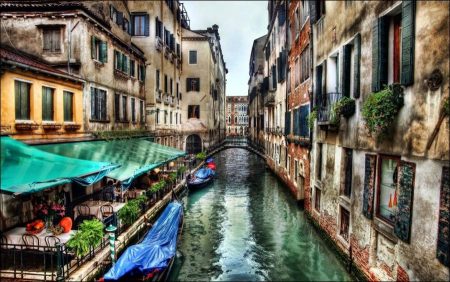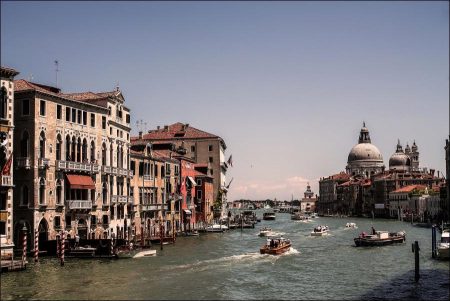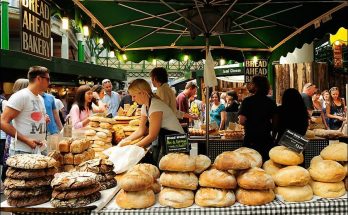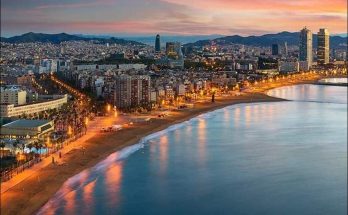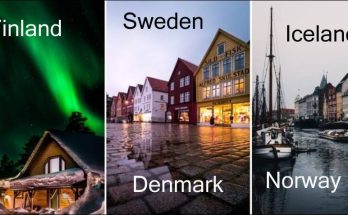Venice is a city unlike any other. No matter how often you’ve seen it in photos and films, the real thing is more dreamlike than you could imagine. With canals where streets should be, water shimmers everywhere. The fabulous palaces and churches reflect centuries of history in what was a wealthy trading center between Europe and the Orient. Getting lost in the narrow alleyways is a quintessential part of exploring Venice, but at some point you’ll almost surely end up in Piazza San Marco, where tourists and locals congregate for a coffee or an aperitif.
Why go now?
Spring is the ideal time to visit La Serenissima – 9 May sees the return of La Biennale to the Giardini, the Arsenale and smaller spaces around the city. Artists from 53 participating countries will be interpreting the theme of this year’s exhibition: “All the World’s Futures”. Another important date in the Venetian calendar is 17 May and the historic Festa della Sensa, or “Marriage to the Sea”, with a parade of rowing boats led by the Serenissima, carrying various local dignitaries.
Touch down
Marco Polo airport is around 12km north of the city on the mainland. A romantic way to arrive in Venice is to chug across the lagoon on the Alilaguna water bus; that leaves from the pier outside the terminal. There are three lines, the seasonal Linea Rossa, running from from now until October, and the Linea Blu that both stop at San Marco, while the Linea Arancio also stops at Rialto. Single fares cost €15 for the 75- to 90-minute journey. Another option is to take AeroBus number 5 to the city’s Piazzale Roma. This costs €6 one-way.
A water taxi from the airport to San Marco costs about €100 and takes 20 minutes. Trains from other parts of Italy arrive at the city’s Santa Lucia Station.
Get your bearings
Resembling a fish hooked by a thin spit of land, the “Queen of the Seas” is a mosaic of 118 small islands linked by 417 bridges. With the Grand Canal meandering down its centre, the city is divided up into six quarters, or sestieri: San Polo, Dorsoduro and Santa Croce on the west side and San Marco, Castello and Cannaregio on the east. St Mark’s Square is the focal point for most visitors, while the rest of the city’s tiny calle, caruggi, sotoportegi, rio teras, salizadas, campos and ramos conspire to make this a bewildering labyrinth (although getting lost is all part of the enchantment).
The square is also the site of the main tourist office. It opens daily from 8.30am to 7pm. The Venezia Unica Citypass; allows you to pre-buy transport tickets, combined entry museum and church passes and wi-fi access on a loaded card. A return AeroBus ticket and 24-hour pass for ACTV vaporetto and bus services within the city costs €28.
Check in
Venice’s hotel scene is about to get some new luxurious arrivals in the form of the St Regis and JW Marriott, both set on islands in the lagoon. Both will no doubt be hoping to create some of the enduring appeal of the Hotel Danieli. This coral pink 14th-century palazzo is a piece of Venetian history, whose former residents include four Doges. Doubles start at €540, room only.
Stay in one of the six tastefully decorated rooms of the intimate Oltre il Giardini, Fondamenta Contarini, San Polo; oltreilgiardino-venezia.com) and you also get the benefit of the secluded garden. In the 1920s the villa was home to the widow of composer Gustav Mahler. Doubles start at €180, with breakfast.
A reasonably priced room can be found at the Generator Venice (10) at Fondamenta Zitelle 86 on Giudecca Island (00 39 041 877 8288; generatorhostels.com). Set in a converted grain store, the hostel’s private rooms start at €45.
Take a ride
It’s an initiation rite for first timers, but there is a cheaper way to experience a gondola. Several points along the Grand Canal have traghetto stops such as the one at Santa Maria del Giglio, with gondolas operating as ferries where there is no convenient bridge. It costs €2 one-way.
Take a hike
Start on the Riva degli Schiavoni and continue west; as you cross the Ponte della Paglia; to your right will be the Bridge of Sighs (13), where prisoners crossed for interrogation. Straight ahead are the twin Columns of San Marco that were the original seafaring entrance to the city.
Bear right into St Mark’s Square, with its beautiful arcades – to your right the Doge’s Palace, and next door the ornate Basilica of San Marco. Pass under the arch at the Torre dell-Orologio and continue up the Mercerie that has been the centre of commercial Venetian life for centuries.
Continue along the Calle Morosina, bear right over the bridge and walk down the Merceria San Salvador, with the 16th-century Church of San Salvatore to your left. Turn right along the Via do April and you will arrive at the Campo San Bartolomeo, with its statue of 18th-century Venetian playwright Carlo Goldini. Turn left down Salizada Pio towards the much-photographed Rialto Bridge (4). Across it you find the colourful Rialto market.
Lunch on the run
Bacari, Venetian wine bars, serve the local take on tapas, cichetti. Cantina Do Mori San Polo has reputedly been open since the mid-15th century. Try the tuna polpetti or tiny sandwiches known as tramezzini washed down with an ombra (a small glass of wine). If you are still peckish stroll down to All’Arco 436 Rialto, for a plate of spiedini (meat skewers).
Window shopping
All the big designer brands are concentrated around Via 22 Marzo and nearby streets. Calle dei Fabbri and the Merceria San Salvadore are jammed with small shops . The streets of Dorsoduro and San Polo are good for browsing.
An aperitif
Cross over the Grand Canal to Dorsoduro. For some this represents the real local side of Venice, often with a more raucous atmosphere thanks to its proximity to the university. Order an Aperol spritz from one of the tables outside Caffè Rosso on Campo Santa Margherita.
Dining with the locals
Al Covo, Campiello della Pescaria, Castello has a refined, nautical interior. Ingredients are sourced locally with an emphasis on fish – marinated anchovies, a gossamer light fritto misto and spaghetti alla vongole with courgette flowers (€50).
For something more casual, Pane Vino e San Daniele has tables spill-ing out onto the peaceful Campo dell’Angelo Raffaele, Dorsoduro; panevinosandaniele.net). It specialises in wine, cheese and cured meats from the Friuli area.
Go to church
Sitting on a thin spit of land between the Grand Canal and the Giudecca Canal in Dorsoduro,Santa Maria della Salute, Campo della Salute is one of the quintessential Venetian landmarks, immortalised by artist J M W Turner. Mass is celebrated on Sundays at 11am.
Out to brunch
Try one of the city’s sublime pastry shops for a coffee and sugary confection. Rosa Salva has a few branches including one at Campo San Giovanni e Paolo with al fresco tables. Around €6.
A walk in the park
Venice is predominantly a city of stone and water. To the east, in Castello, along the Riva dei Partigiani waterfront, is one of the few verdant splashes, the Giardini Pubblici. During the Biennale, the adjacent Biennale Pavilions will be open to ticketholders (9 May to 21 November, 10am-6pm Tuesday-Sunday). Admission costs €25.
Cultural afternoon
The imposing Ca’Pesaro, Sante Croce is staging “Paradise”, a retrospective of the work of American painter Cy Twombly (10am-6pm, Tuesday-Sunday; €10). If your tastes lean towards the historic, the Doge’s Palace on St Mark’s Square is a high point of Venetian Gothic architecture. On 1 April it launched a new guided tour, “The Doge’s Hidden Treasures”, following restoration in private apartments. Booking is essential for the daily English tours at 11.45am (€20, or €14 with a UnicaVenice card).
The icing on the cake
Glassmaking is synonymous with Murano, a history chronicled at Museo del Vetro, Palazzo Giustinian, Fondamenta Giustinian. It reopened in February following renovations (daily 10am-6pm; €10).
Views: 176
